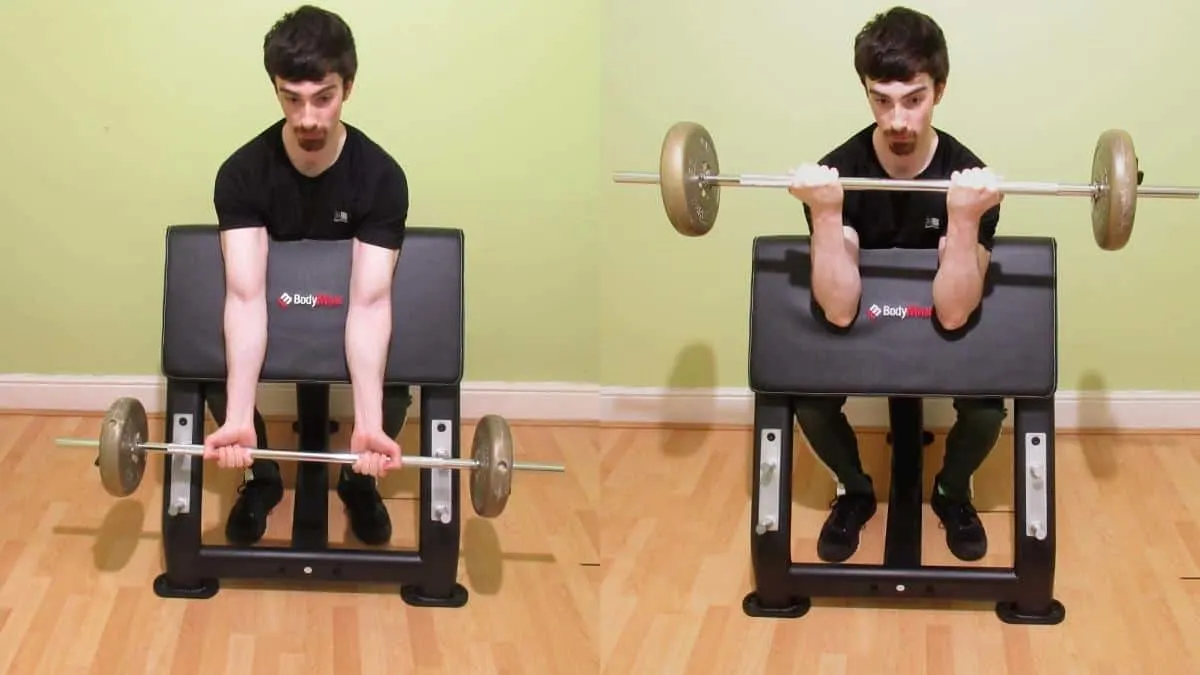The barbell preacher curl is a tremendous mass-building movement for the biceps because it enables you to overload your arms with high amounts of weight.
Furthermore, unlike in a regular preacher curl, the straight bar preacher curl trains your biceps in their fully supinated position. This means that you naturally receive a stronger muscle contraction and, with an appropriate diet and good recovery, more muscle growth as well.
The preacher pad is particularly handy for maintaining good form because you can’t use your other muscles to swing the weight up like you can in a standard barbell curl. But as you’ll soon learn, there are also some drawbacks to this exercise that you need to consider before integrating it into your training regime.
Related: Chest and biceps workout
Barbell preacher curl exercise details
- Main Muscles: Biceps brachii
- Secondary Muscles: Brachialis, brachioradialis, forearm flexors
- Exercise Type: Strength
- Exercise Mechanics: Isolation
- Difficulty Level: Beginner
- Equipment Needed: Barbell, preacher pad, weight plates
How to perform barbell preacher curls
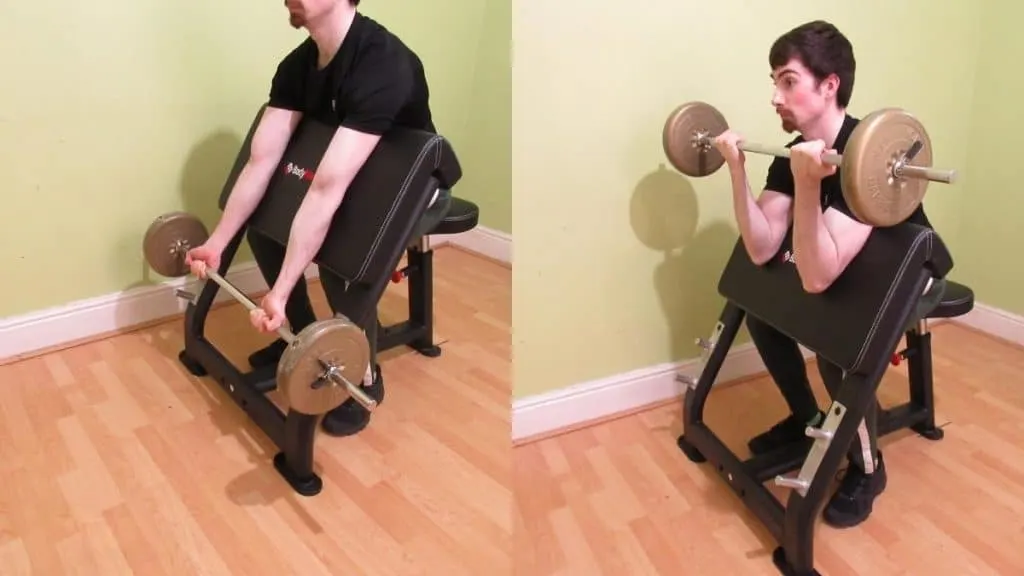
- Place a straight bar in the rack of a preacher curl station.
- Sit on the seat of the preacher curl bench.
- Brace your arms against the sloped side of the pad so that your armpits are resting on the very top of the pad.
- Grab the bar with an underhand, shoulder-width grip.
- Curl the barbell toward your front delts.
- Keep curling until your biceps and forearms make forceful contact.
- Hold the contraction for a moment and then lower the barbell under control until your elbows are fully extended.
- Repeat the motion for 3-5 sets of 8-12 reps.
Barbell preacher curl advantages
As you’ll learn in the next section, barbell preacher curls aren’t for everyone because they can be quite tough on your connective tissue. However, compared to the one arm dumbbell preacher curl, straight bar preacher curls offer undeniable mass-building advantages that no weight lifting enthusiast or bodybuilder should ignore.
Better bicep contractions
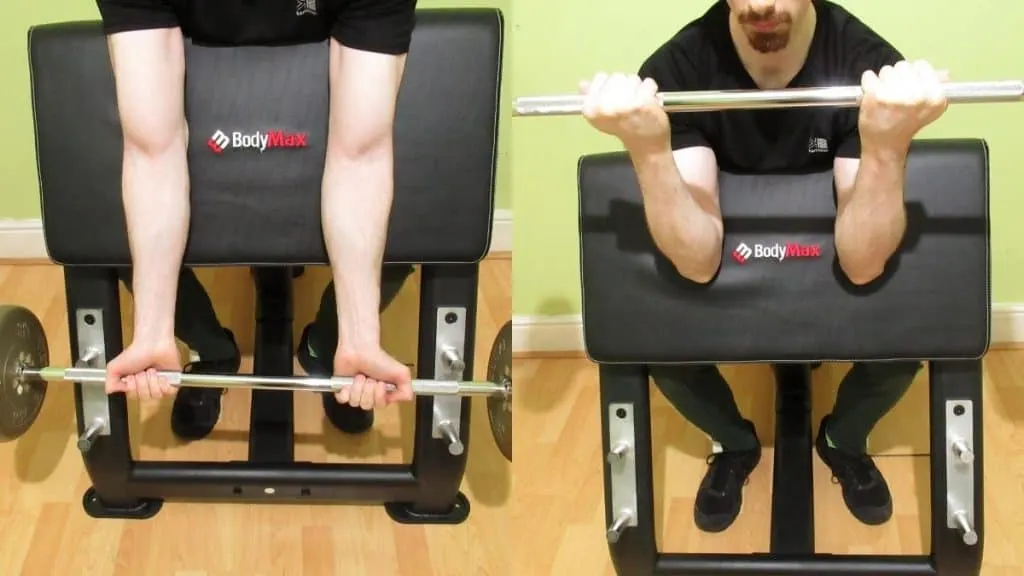
Unlike the hammer preacher curl and the regular preacher curl, the barbell preacher curl trains the biceps in a fully supinated position. This results in a powerful muscle pump because when the biceps are fully supinated, they’re by definition maximally contracted as well.
What this means for you is that you get better bicep stimulation (compared to using an EZ bar) because now your biceps are fully contracted instead of being just partially flexed.
Of course, to get this benefit, it’s vital that you lift with a full range of motion; otherwise, you’ll be robbing your biceps of that all-important growth-stimulating muscle contraction.
Just make sure to lower the bar all the way down as well. The barbell preacher curl is certainly one of the great lower bicep exercises, but you need to be willing to put your ego aside and lift lighter weights in order to get a proper stretch and contraction.
Easy progressive overload
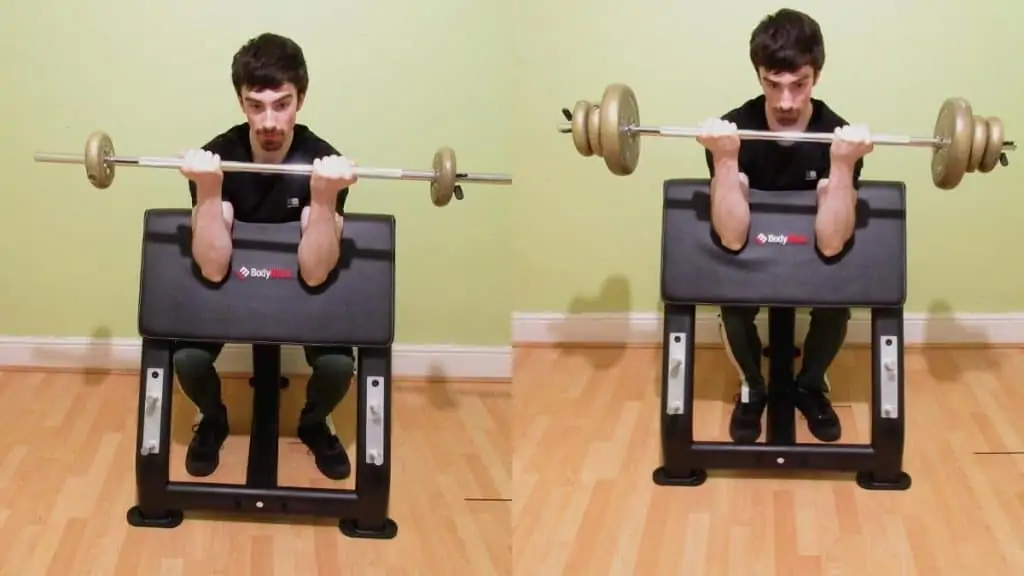
Dumbbells are an excellent training tool—there’s no denying that. Still, increasing the resistance often means making 5lb weight jumps per side at a minimum. Such a steep increase is impractical for a relatively small muscle group like the biceps because a 5lb increase could easily be equal to a 20% increase for many people.
The solution is to use barbells so that you can microload the resistance in more manageable increments.
In practice, you can just use the smallest plates that you or your gym has available. But if you want to take your microloading to the next level, then you can invest in a set of dedicated microplates, which will enable you to increase the resistance more frequently and thus gain strength faster.
Boosting the resistance by 0.5-1lb per side might not seem like much, but if you’re bumping up the weight on even a semi-regular basis, then those small additions will really start to stack up over the long term. Then, before you know it, you’ll have significantly increased your straight bar preacher curl strength, which leads me nicely onto the next advantage.
More bicep mass
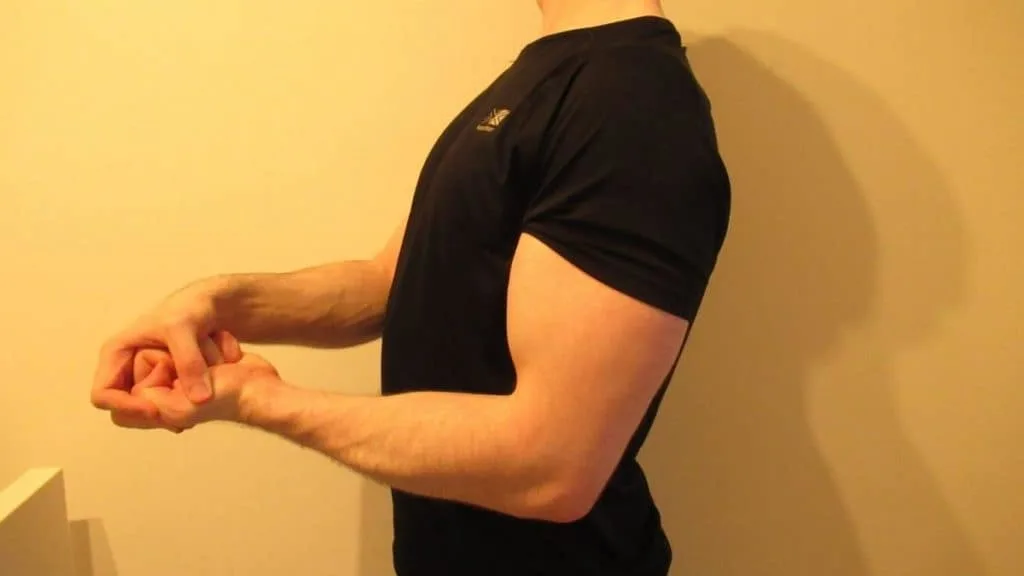
Barbells enable you to lift heavier than any other free weight training tool because they’re the most conducive to progressive overload. Therefore, not only will your biceps become stronger from performing preacher barbell curls, they’ll become bigger and more sculpted too. [1]
Like barbell preacher curls, seated straight bar curls also make it harder to cheat the weight up—thereby ensuring that the tension stays on the target muscles— because you can’t use your legs or back to generate momentum. However, the preacher version still reigns supreme in the land of bicep curls because your arms are braced against the pad, which means that you also can’t use your shoulders to swing the bar up.
Just make sure that your diet is healthy and high enough in protein. While it’s important to train hard in order to stimulate protein synthesis, you need to supplement your efforts with equal discipline in the dietary arena if you actually want to gain new muscle tissue.
Barbell preacher curl disadvantages
Barbell exercises have been building the biceps of bodybuilders for decades, and the preacher bench barbell curl is no exception. However, if you have particularly poor connective tissue health or a penchant for ego lifting, then you might want to think twice about incorporating the straight bar into your bicep training.
Higher chance of wrist strain

Performing your preacher curls barbell style necessitates keeping your wrists in a fixed, supinated position. This fully supinated position isn’t the normal way that we hold our wrists in every life, so if you’re lifting especially heavy weights, then you might be putting your wrists under excessive amounts of strain.
You may be able to circumvent this problem by sticking to high repetitions. But if you have particularly fragile wrist joints, then you might still find the straight bar to be too uncomfortable. If this is the case, you can always try performing cable preacher curls, which typically provide more joint-friendly resistance for the majority of lifters.
More forearm stress
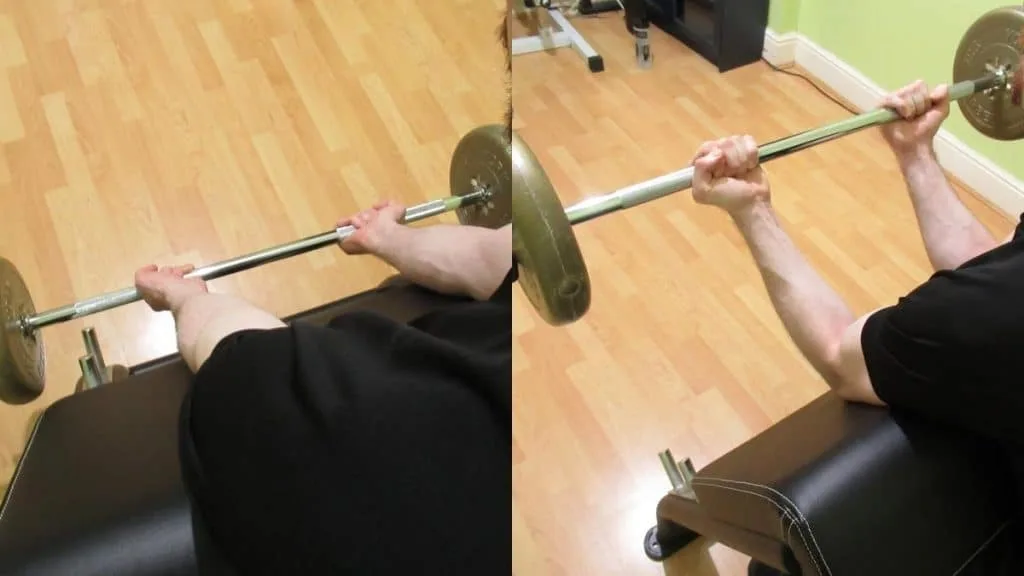
Once again, performing preacher barbell curls means keeping your forearms in a fixed, maximally supinated position. This positioning naturally places your forearm flexors under a significant amount of strain, and it can even lead to conditions like splints and tendonitis if you perform excessive training volume in conjunction with the supinated grip. [2]
Read More: Straight bar spider curls │Biceps and shoulders workout
Should you do straight bar preacher curls for your biceps?
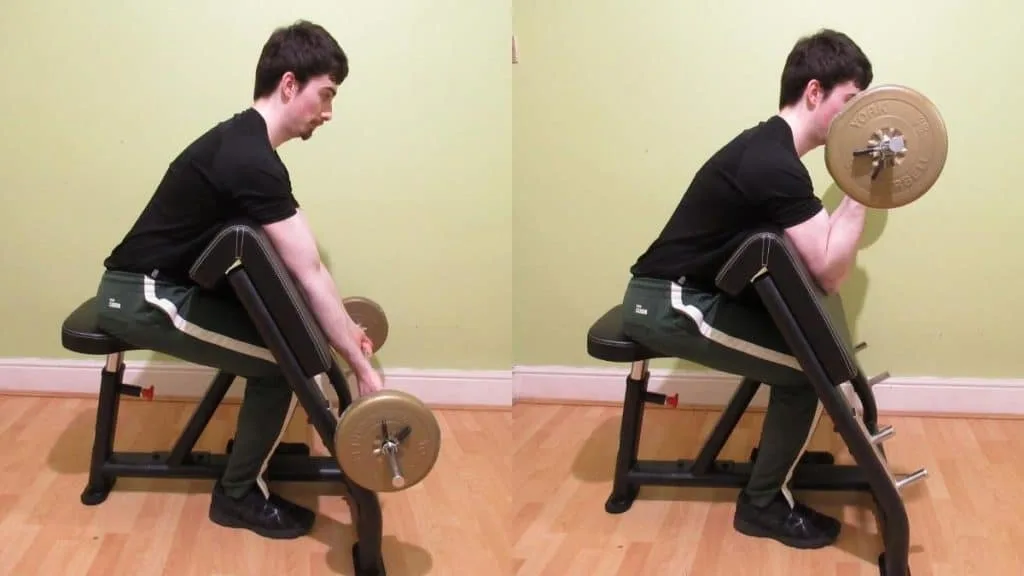
The barbell preacher curl is the undisputed king of building mass in many respects. Unlike the hammer barbell curl, the straight bar preacher curl is highly conducive to maximum bicep isolation because the pad makes it virtually impossible to cheat the weight up.
Additionally, preacher barbell curls force your biceps into a fully supinated position throughout the whole duration of the set. While this position can cause injuries for some lifters, it’s the most effective grip to use for preacher curls—in theory—because, along with elbow flexion, forearm supination is actually one of the two primary bicep functions.
Overall, it’s recommended to perform barbell preacher curls for 3-5 sets of 8-12 reps, ideally at the start of your barbell biceps workout if your goal is to build mass.
On the other hand, if your joints struggle to tolerate the harshness of the straight bar, then you can also perform straight bar preacher curls at the end of your training session for higher repetitions. This way, you’ll naturally have to lift less weight because your biceps will already be fatigued, which means that your joints and connective tissue won’t be placed under as much stress as they otherwise would be if you were doing the exercise at the beginning of your workout.
References
- Nunes, J. P., Jacinto, J. L., Ribeiro, A. S., Mayhew, J. L., Nakamura, M., Capel, D. M. G., Santos, L. R., Santos, L., Cyrino, E. S., & Aguiar, A. F. (2020). Placing Greater Torque at Shorter or Longer Muscle Lengths? Effects of Cable vs. Barbell Preacher Curl Training on Muscular Strength and Hypertrophy in Young Adults. International Journal of Environmental Research and Public Health, 17(16), 5859. https://doi.org/10.3390/ijerph17165859
- Wadhwa, S. S., Mansberg, R., Fernandes, V. B., & Qasim, S. (1997). Forearm Splints Seen on Bone Scan in a Weightlifter. Clinical Nuclear Medicine, 22(10), 711–712. https://doi.org/10.1097/00003072-199710000-00014

